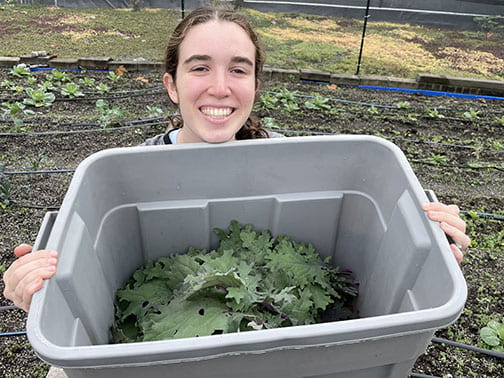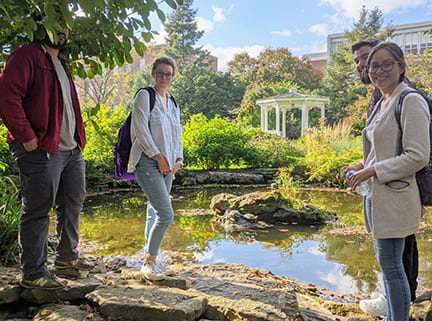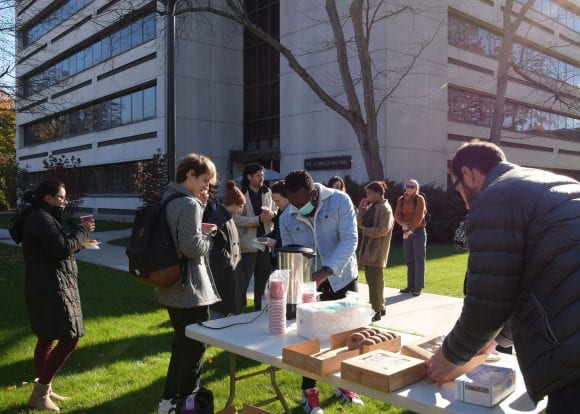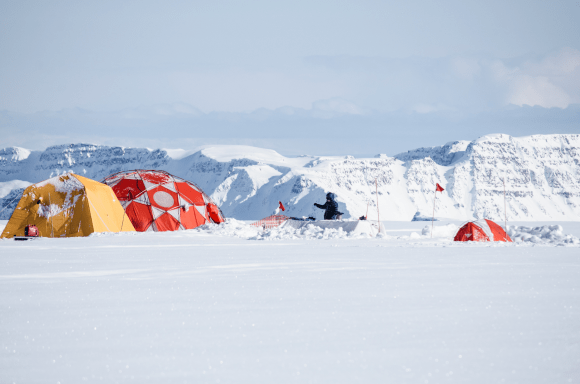IMAGE OF THE WEEK

Ruchi Patel (right) was interviewed live on Salvadoran national TV in October in recognition of the Fulbright Program’s 75th anniversary. Patel spoke about her research and experiences as a Fulbright student in El Salvador so far, as well as what she hopes to gain through cultural exchange. Patel also participated in a Facebook Live panel hosted by the US Embassy as a part of the 75th anniversary week.
GOOD NEWS
An Apple Cider Social will be held by Department of Geography on Friday, Nov. 5 at 3 p.m. on the lawn outside Walker Building.
Chris Fowler is serving on Pa. redistricting advisory council which held a listening session on the redistricting process at University Park campus on Nov. 1. He also was interviewed on the WPSU show Democracy Works about gerrymandering, and wrote an opinion column, published in the Oct 20 issue of the Centre Daily Times.
Wendy L. Zeller Zigaitis was selected to be a member of the American Association of Geographers (AAG) organizing committee for a Geography Essentials workshop series for summer 2022.
Matthew Popek, who earned his bachelor of science in geography in 2009, was awarded the Pennsylvania Chapter of the American Planning Association’s 2021 Award for Leaders in the Emerging Planner category. In his acceptance speech at the state planning conference in October in Pittsburgh, he acknowledged Roger Downs’ impact on his education and career trajectory.
Nov. 9, noon EST, 125th Anniversary Virtual Education Series: Brian King on “Infectious Addictions: Geographies of Colliding Epidemics.” This virtual educational series is sponsored by the College’s Graduates of Earth and Mineral Sciences (GEMS) Board of Directors and will spotlight the College’s research in short interactive webinars to engage your curiosity and introduce you to our world-class faculty and alumni. Register at: https://engage.tassl.com/event/9341.
Supporting Women in Geography (SWIG) is again participating in the Centre Safe Holiday Sponsor program. Their goal is to raise $250 by Monday, Nov. 15. Donations can be dropped to the collection envelope in Casey Hamilton’s mailbox (304 Walker Building), or via Venmo to @Timothy-Prestby (comment ‘Holiday gift basket’).
Penn State University Libraries and the Department of Geography will observe GIS Day — an annual event celebrating the technology of geographic information systems (GIS) — with a virtual event from 1:30 to 3:30 p.m. on Tuesday, Nov. 16. Geographers Joshua Inwood, Brandi Gaertner, Louisa Holmes, and Harrison Cole will give talks.
Elham Nasr Azadani was selected to give a lightening talk, “Supporting Equity in Participatory Natural Resource Policy and Management,” at the American Geographical Society’s (AGS) Geography 2050 Symposium, to be held Nov. 15–19, 2021.
COFFEE HOUR
The Biden Infrastructure plan proposes $2 trillion investments in new infrastructure throughout the United States. It is building on economic theories of public spending that predate today’s lingering neoliberalism. It proposes projects specifically addressing environmental conservation, climate change mitigation and adaptation. However, the place of tribes and Indigenous nations in this new public spending initiative is uncertain. This presentation asks: “What political and economic changes and risks to Indigenous sovereignty might this new public spending initiative portend for Indigenous nations?”
NEWS
Air humidity is more important than soil moisture in influencing whether it rains in the United States Corn Belt, an agricultural area in the Midwest, stretching from Indiana to Nebraska and responsible for more than 35% of the world’s most important grain crop, according to a new study by Penn State researchers.
Daniel Selik, a student in the intercollege Master of Professional Studies in Homeland Security (iMPS-HLS) degree program at Penn State and a retired U.S. Navy chief petty officer, received the 2021 Michael P. Murphy Award in Geospatial Intelligence.
Anthony Robinson is on the research team
How much people moved around town predicted COVID-19 cases in a rural Pennsylvania county in 2020, according to a new study by researchers at Penn State.
RECENTLY PUBLISHED
Mixed-Severity Wildfire as a Driver of Vegetation Change in an Arizona Madrean Sky Island System, USA
Helen M. Poulos, Michael R. Freiburger, Andrew M. Barton, Alan H. Taylor
Fire
https://doi.org/10.3390/fire4040078
Fire is a powerful natural disturbance influencing vegetation patterns across landscapes. Recent transitions from mixed-species forests to post-fire shrublands after severe wildfire is an increasingly prevalent phenomenon in pine-oak and conifer forest ecosystems in southwestern North America. However, we know little about how variation in fire severity influences other common forest types in the region. In this study, we evaluated fire-induced changes in woody plant community composition and forest structure in Chiricahua Mountains in southeastern Arizona in the United States that hosts a diverse set of vegetation types. Cluster analysis of the pre-fire vegetation data identified three dominant pre-fire vegetation types including juniper woodland, piñon forest, and pine-oak forest. All vegetation types experienced significant tree mortality across a wide range of size classes and species, from forests to shrublands. The magnitude of change within sample plots varied with fire severity, which was mediated by topography. Significant shifts in dominance away from coniferous obligate seeder trees to resprouting hardwoods and other shrubs occurred across all vegetation types in response to the fire. Regeneration from seed can be episodic, but projected increases in aridity and fire frequency may promote continued dominance by hardwoods and fire- and drought-resistant shrub communities, which is a regional forest management concern as wildfire size and severity continue to increase throughout the southwestern USA.
Move The Object or Move The User: The Role of Interaction Techniques on Embodied Learning in VR
Bagher Mahda M., Sajjadi Pejman, Wallgrün Jan Oliver, La Femina Peter C., Klippel Alexander
Frontiers in Virtual Reality
https://www.frontiersin.org/article/10.3389/frvir.2021.695312
To incorporate immersive technologies as part of the educational curriculum, this article is an endeavor to investigate the role of two affordances that are crucial in designing embodied interactive virtual learning environments (VLEs) to enhance students’ learning experience and performance: 1) the sense of presence as a subjective affordance of the VR system, and 2) bodily engagement as an embodied affordance and the associated sense of agency that is created through interaction techniques with three-dimensional learning objects. To investigate the impact of different design choices for interaction, and how they would affect the associated sense of agency, learning experience and performance, we designed two VLEs in the context of penetrative thinking in a critical 3D task in geosciences education: understanding the cross-sections of earthquakes’ depth and geometry in subduction zones around the world. Both VLEs were web-based desktop VR applications containing 3D data that participants ran remotely on their own computers using a normal screen. In the drag and scroll condition, we facilitated bodily engagement with the 3D data through object manipulation, object manipulation. In the first-person condition, we provided the ability for the user to move in space. In other words, we compared moving the objects or moving the user in space as the interaction modalities. We found that students had a better learning experience in the drag and scroll condition, but we could not find a significant difference in the sense of presence between the two conditions. Regarding learning performance, we found a positive correlation between the sense of agency and knowledge gain in both conditions. In terms of students with low prior knowledge of the field, exposure to the VR experience in both conditions significantly improved their knowledge gain. In the matter of individual differences, we investigated the knowledge gain of students with a low penetrative thinking ability. We found that they benefited from the type of bodily engagement in the first-person condition and had a significantly higher knowledge gain than the other condition. Our results encourage in-depth studies of embodied learning in VR to design more effective embodied virtual learning environments.
Land use change dynamics in Euro-mediterranean mountain regions. Driving forces and consequences for the landscape
Jiménez-Olivencia, Yolanda, Ibáñez-Jiménez, Álvaro, Porcel-Rodríguez, Laura, Zimmerer, Karl
Land use policy
https://dialnet.unirioja.es/servlet/articulo?codigo=8105932#
The marginalization of mountain regions in Mediterranean Europe since the mid-20th Century has triggered important socioeconomic and environmental changes that are putting the survival of highly regulated and environmentally adapted landscapes in jeopardy. We still have only a limited understanding of the driving forces behind these dynamics of change and their final consequences for the structure and character of the landscape. In general, the transformation of the landscape and its causes have been studied at regional and local level and various syntheses have been made for Europe or the Mediterranean as a whole, focusing above all on changes in the use of farmland. The objective of this paper is to provide a holistic view of the changes that have taken place in the landscape in the Euro-Mediterranean region, focusing in particular on the mountains because of their role as heritage reserves and as sources of environmental services. This research involves a systematic review of the evidence about the dynamics of land use change, its underlying drivers and their effects on the landscape. We analyse 53 case studies from 6 countries situated on the northern shores of the Mediterranean. These studies covered a period of around 40 years and were each performed at a local scale. The results reveal that landscape change is caused above all by the abandonment of farmland and reforestation (in over 90% of cases), and by pressure from urban development in the case of coastal and peri-urban mountain ranges. In addition, the dominant dynamics in each case vary depending on the bioclimatic area in question, to the extent that bioclimate has been shown to be an important explanatory factor behind these dynamics. The underlying boosters of change normally act together and those most commonly cited are economic, demographic and geographic. As regards the impacts on the structure and character of the landscape, the dynamics analysed are manifested first and foremost in degradation processes, in an increase in homogenization, which affects above all the most humid bioclimates, and in the fragmentation of open spaces. This analysis provides a general overview of the causes and consequences of the changes in land use in the mountain regions of Mediterranean Europe and raises questions of interest for policy-making that affects the landscape.
Where to place emergency ambulance vehicles? Using a capacitated maximum covering location model with real call data
Soheil Hashtarkhani, Ping Yin, Behzad Kiani, Alireza Mohammadi, Shahab Mohammad Ebrahimi, Mahmood Tara, Stephen A. Matthews
International Journal of Health Geographics
10.21203/rs.3.rs-994111/v1
Background: Timeliness of emergency medical services (EMS) is critical for patient survival. Identifying optimal locations for ambulance vehicles could increase the chance of timely service delivery. This study incorporates Geographical Information Systems (GIS) with a mathematical optimization technique to improve the 5-minute coverage of EMS demands.
Methods: This study was conducted in the county of Mashhad, the northeast of Iran, including 94 ambulance vehicles distributed across 74 EMS stations. Locations of demands were extracted using analysis of one-year EMS call data. Network analysis was employed to estimate the travel times. A maximal covering location problem (MCLP) model with a capacity threshold for vehicles was implemented using the CPLEX optimizer. To make the proposed model more practical in the context of EMS, we added a constraint to the model formulation to maintain an acceptable service level for all EMS calls. Two scenarios were implemented: (1) a relocation model of existing vehicles among existing stations and (2) an optimal allocation model of EMS vehicles and stations using a list of candidate locations.
Results: Using the relocation model, the proportion of calls for service within the 5-minute coverage standard increased from 69% to 75%, ensuring all urban and rural service demands to be reached within 16 and 48 minutes, respectively. Our allocation model revealed that the coverage proportion could rise to 84% of the total call for service by adding ten vehicles and eight new stations.
Conclusions: Incorporating GIS techniques with optimization modeling has the potential to improve population health outcomes in real-world decision making regarding the accessibility and equity of health










